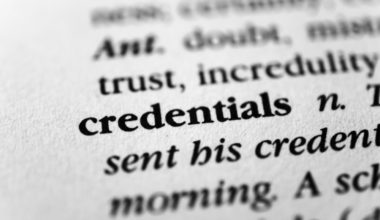 Definitions are sourced from the American Council on Education’s Quality Dimensions for Connected Credentials (2016) and Lumina Foundation’s Connecting Credentials: A Beta Credentials Framework (2015).
Definitions are sourced from the American Council on Education’s Quality Dimensions for Connected Credentials (2016) and Lumina Foundation’s Connecting Credentials: A Beta Credentials Framework (2015).
What are credentials?
The most common higher education academic credentials are associate, bachelor’s, and graduate degrees. But U.S. postsecondary credentials include thousands of different certificates, certifications, licenses, and increasingly also badges. Therefore, in order to provide a framework for understanding connected credentials, we need to define what we mean by “credentials.”
The framing definition of credentials comes from Lumina Foundation’s Connecting Credentials Initiative:
Credential:
A documented award by a responsible and authorized body that has determined that an individual has achieved specific learning outcomes relative to a given standard. Credential in this context is an umbrella term that includes degrees, diplomas, licenses, certificates, badges, and professional/industry certifications” (Lumina Foundation 2015a, 11).
Types of Credentials
Degree:
Academic degrees in the United States are credentials awarded by accredited, postsecondary, educational institutions based on the student’s completion of a specified program of study. There are basically four levels of degrees: associate, bachelor’s, and graduate (master’s and doctoral). Although there is considerable variation in requirements depending on the institution and field of study, the associate-level degree usually requires the completion of approximately 60 semester credits (approximately two years of full-time study), and the bachelor’s level degree usually requires 120 to 130 semester credits (approximately four years of full-time study, including some specialization). The bachelor’s degree is generally considered the gateway to graduate degrees and advanced studies. Graduate degrees vary based on specialization, but a master’s degree usually requires an additional one to two years of full-time study beyond a bachelor’s, and a doctoral degree approximately four years beyond a bachelor’s.
Diploma:
An official document issued by an educational institution that records the achievements of an individual following the successful completion of an academic course of study, typically requiring fewer credits than an associate degree.
Certificate:
A credential awarded by a training provider or educational institution based on completion of all requirements for a program of study, including coursework and tests or other performance evaluations. Certificates are typically awarded for life (like a degree). Certificates of attendance or participation in a short-term training (e.g., one day) are not in the definitional scope for educational certificates (Bielick et al. 2013, 5).
Certification:
A credential awarded by a certification body based on an individual demonstrating through an examination process that he or she has acquired the designated knowledge, skills, and abilities to perform a specific job. The examination can be either written, oral, or performance-based. Certification is a time-limited credential that is renewed through a recertification process (Bielick et al. 2013, 5).
License/Licensure:
A process by which a governmental agency grants time-limited permission to an individual to engage in a given occupation after verifying that he or she has met predetermined and standardized criteria. Practice in a licensed occupation is restricted to those possessing a license. The requirements for licensure vary by state, based on legislative and regulatory requirements.
Badge:
Badges use digital technologies to represent learning achievements; however, not all digital badges are open badges, in that not all badges use open standards that support interoperability and connections among systems and contexts. In this paper, “badge” refers to “open badges” and therefore includes technical and conceptual frameworks for openness, transparency, and interoperability (for more context on open badges, see Derryberry, Everhart, and Knight 2016). “Badges signify accomplishments such as completion of a project, mastery of a skill, or marks of experience” (Casilli and Knight 2012, 1) and can be created and awarded by institutions, organizations, groups, or individuals. Badges are flexible with regard to how issuers create them, define their use, and develop their criteria (which are publicly viewable, embedded in the badge, and verifiable). Therefore badges can be used in numerous ways to meet a community’s needs, to represent granular competencies as well as deeply linked, rich experiences and complex learning. Badges are being used in conjunction with and/or as modular components of traditional credentials such as degrees. In some cases, especially when badges link to evidence, they are being used as representations of credentials. Badges can expire or be revoked, making them useful for credentials that are not continuously valid. Given their flexibility, badges bridge traditional, accredited credentials, professional and industry-recognized credentials, and nontraditional, experimental credentials.
Lexicon of other Select Credential Phrases
Competency:
“A learnable, measurable, role-relevant, and behavior-based characteristic or capability of an individual.” In the Connecting Credentials Framework, competencies “are broken into two learning domains: knowledge and skills. The latter domain is broken into three sub-domains: specialized skills, personal skills and social skills” (Lumina Foundation 2015a, 2. See also Everhart, Bushway, and Schejbal 2016). Note that a focus on the value of competencies is not the same as “competency-based education,” that is, the restructuring of academic programs to focus on mastery of competencies rather than focusing on time.
Stackable credential:
A credential that is part of a sequence of credentials that can be accumulated over time to build up an individual’s qualifications and help that individual move along a career pathway to further education, different responsibilities, and potentially higher-paying jobs.” (see also Ganzglass 2014)
Career pathway:
“The career pathway approach connects progressive levels of education, training, support services, and credentials for specific occupations in a way that optimizes the progress and success of individuals with varying levels of abilities and needs. This approach helps individuals earn marketable credentials, engage in further education and employment, and achieve economic success. Career pathways deeply engage employers and help meet their workforce needs; they also help states and communities strengthen their workforces and economies.”
